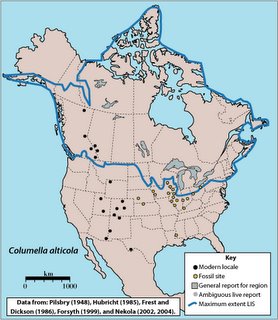If you aren't moving at a snail's pace, you aren't moving at all. -Iris Murdoch
Saturday, December 31, 2005
Friday, December 30, 2005
Snail biogeography

I drew the above distribution map for Columella columella alticola based on several sources (see graphic), including my own research. The open circles are Pleistocene fossils and the dark dots are modern sites where they are found. The species name indicates it's simlilarity to the European species C. alticola. So how does a snail so similar to its European cousin get across North America? Aydin at Snail's Tales discussed the distribution of another holarctic land snail. One of his suggestions for distribution on two continents was via plate tectonics. Personally, I think genetic drift would have resulted in greater phenotypic difference over the 200 million years since Europe and North America were last next door neighbors.

Columella columella alticola and snail eggs as Pleistocene fossils from the midwest.
If not tectonics, then what? Looking at the distribution, I wonder if many species of snail took advantage (if I may anthropomorphize a little) of the Bering land bridge. Given that there are several species that share this holarctic distribution (eg: Z. harpa, C. columella, P. muscorum). So, how do they do it? Birds, wind, large mammals? And how might one differentiate between distrubution via tectonics versus land bridges? DNA studies for one, but the other would be better time control on fossil distribution. A project too grand in scope for my own dissertation, but perhaps there are some paleontologists who have already started on this project?
Food for thought on the penultimate day of 2005...
Friday, December 09, 2005
Snail dispersal idea.
I have been wondering about snail dispersal - do they really get caught up with large mammals and birds? I'd be interested in doing a country-wide study next hunting season: taking a flea comb and looking for snails caught in the fur of deer taken during hunting season. Anyone else interested in looking for snails caught up in megafauna?
Thursday, December 08, 2005
Yo y el pajaro, numero doce.
Twelfth installment of I and the bird up at Search and Serendipity. Check it out.
Sunday, December 04, 2005
A bird in the hand...

Last year my wife and I took a trip to Rocky Mountain National Park. Normally, one might go to a beautiful spot like RMNP and not take their camera out until they get within the park. But, this little campground just south of Estes Park provided me with the signature image of that trip. It's a Broad Winged Hummingbird female, waiting to get a shot at the nectar feeders set up near the camp check-in. Keep your camera handy - you never know when an image will come.
Subscribe to:
Posts (Atom)